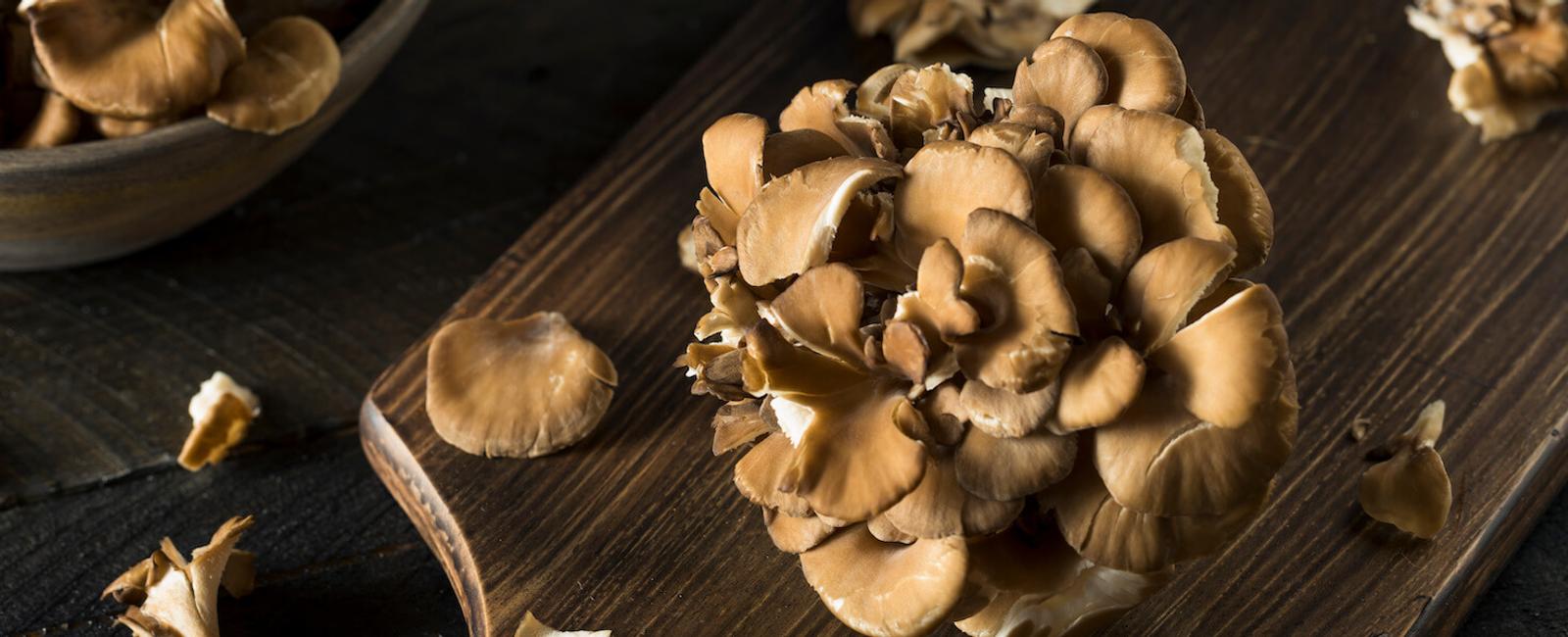

Medicinal mushrooms have been used for centuries in Eastern medicine traditions. No longer separated by centuries, anyone can enjoy exploring the world of mushrooms and learning how to incorporate them into their day. One of the most revered is the maitake mushroom. Treasured for hundreds of years, this mushroom is brimming with health benefits and worth getting to know. In this guide, we’ll explore maitake mushrooms, how to identify them, where they grow, and more.
What are maitake mushrooms?
Maitake mushrooms (grifola frondosa) are a type of medicinal mushroom. Unlike culinary mushrooms, medicinal mushrooms are valued for their medicinal properties and have a long history of use in Eastern medicine traditions.
These mushrooms go by a few other names too. Hen of the woods mushroom, sheep’s head, dancing mushroom, cloud mushroom, and dancing butterfly mushroom are all names for maitakes (1). Once you get a chance to see how beautiful this mushroom looks in real life, it’s easy to understand why it has such descriptive names.
What do maitake mushrooms look like?
Describing maitake mushrooms as beautiful isn’t an understatement. Hen of the woods mushrooms typically start out a brownish-dark gray when they’re young and become lighter in color as they age. Instead of a single mushroom cap at the end of a single stem, they grow in clusters; maitake mushrooms have multiple overlapping caps from branched stems sharing a joint base. These mushroom caps look more like a fluffy hen’s tail feathers or mini palm fronds and can sometimes have a slightly fuzzy texture (1).
History of maitake mushrooms

While sometimes it may seem like medicinal mushrooms are more of a recent wellness trend, that isn’t the case. Some of the first medical texts document using medicinal mushrooms in treating ailments dating back to 200 AD (2).
A materia medica is a guide that describes the properties, functions, and indications of a substance used in medicine. Think of it as the ultimate resource to consult when looking for a way to rebalance and heal the body.
While we may often hear about a materia medica as it relates to Eastern medicine, it isn’t solely associated with traditional Chinese medicine or the Japanese Kampo tradition of herbal medicine. A Greek medical botanist, Pedanius Dioscorides, penned his own version, eventually forming the foundation of European and Western pharmacopeia (3).
Remember when we talked about some of the other names maitake mushrooms are known as? One of those, dance mushroom, is the direct translation of maitake. Japanese folklore tells the tale of a band of woodcutters and nuns who happen upon a maitake mushroom in the forest. They’re so overcome with excitement that they dance with joy at their discovery.
Another legend centers on how valuable maitake mushrooms were during Japan’s feudal period. So valued and prized were maitake mushrooms that the shogun—hereditary military leaders appointed by the emperor—would pay the mushroom’s weight in silver (4).
Health benefits of maitake mushrooms
Like many medicinal mushrooms, maitake mushrooms are loaded with health benefits. Here’s how hen of the woods mushrooms can support your body and enhance your overall wellness.
- Nurturing your immune system: Maitake mushroom’s beta-glucans and polysaccharides can support your immune system and improve immune function. Another compound, D-fraction, boosts lymphokines and interleukins that positively affect immune response (5). Research has demonstrated that these compounds have anti-tumor effects and will attack breast cancer cells. Their effects are even more pronounced when combined with vitamin C (6).
- Balancing blood sugar: Compounds in hen of the woods mushrooms have demonstrated an ability to lower blood glucose levels and reduce insulin resistance, which can be helpful not only for overall wellness, but also for managing diabetic health conditions.
- Supporting heart health: Beta glucans for the win! Regarding heart health, beta-glucans in maitake mushrooms can reduce cholesterol levels, improve artery health, and lower your risk of heart disease. There’s also evidence these mushrooms may help manage blood pressure too.
- Encouraging overall wellness: It isn’t just about polysaccharides and beta-glucans; maitake mushrooms are an excellent source of antioxidants and other nutrients. Loaded with vitamin D, potassium, and antioxidants, along with being a good source of dietary fiber, maitake mushrooms are profoundly nourishing to the body (5).
Where do maitake mushrooms grow?

Like many mushroom species, maitake mushrooms prefer temperate forest environments. These striking mushrooms are indigenous to northeastern regions of Japan, although they grow elsewhere, including Eastern Canada and the Northeastern and Mid-Atlantic states; seldom do you find them in North America’s northwest or southeastern regions. There are even parts of China and Europe where you can see them growing at the base of oak trees or other hardwoods like elm, maple, beech, and black gum (1).
Psst: Some clusters of maitake mushrooms can get quite large, with some weighing in at 40 or 50 pounds each. Some have even weighed as much as 100 pounds! Growing conditions, nutrient availability, humidity, and temperature all play a role in how large a maitake mushroom cluster will grow.
Ethically wildcrafting maitake mushrooms
While it may not seem like it, there’s a difference between ethically wildcrafting mushrooms and foraging them. Wildcrafting has much more to do with gathering resources for their medicinal value. In contrast, foraging focuses on simply gathering food resources in the wild.
Wildcrafting also involves harvesting plants or mushrooms in a slow, sustainable way that is respectful to the environment and allows for continued growth. Foraging refers to simply picking and gathering without regard to sustainability or potential environmental damage. That doesn’t mean that foraging is reckless, although it can be.
One of the most significant differences is the approach to harvesting. Ethically wildcrafting a resource takes several factors into consideration and is more nuanced. More thought is put into how harvesting a mushroom will affect the ecosystem and how to do so without damaging the delicate mycelial network beneath the surface of the fruiting body. Consideration to not overharvest is also top of mind as we aren’t the only ones who enjoy feasting on wild mushrooms. Other plants and animals rely on them as a food source; it’s wise to remember we are sharing the resources nature has to offer.
Educate yourself on local mushroom species not only for successful identification, but also to be aware of any endangered or threatened mushrooms in your area. Learn what’s safe to harvest and what isn’t. It’s best to consult a professional if you’re still determining mushroom identification.
Gathering your own food is an age-old tradition we’ve lost touch with as time and technology have advanced, but it doesn’t have to be. With a bit of effort and time, you can reconnect with nature respectfully and meaningfully. Make a point to be mindful and avoid being one of the foragers who may take what nature has to offer for granted.
Consider the GIY (grow it yourself) option
Suppose wildcrafting maitake mushrooms isn’t an option in your area, or you can’t find them at your local grocery store. In that case, consider growing your own hen of the woods mushrooms. While many mushrooms are easy to cultivate at home, maitake mushrooms sometimes fall into a different category. It may take some practice and quite a bit of patience before you can harvest your own maitake mushrooms. Nonetheless, growing your own mushrooms at home is well worth the effort.
Whether you’re brand-new to mushroom cultivation or are a seasoned expert looking to troubleshoot, check out mushroom forums for tips and ideas. These online communities are a fantastic way to connect with like-minded folks and learn about mushrooms. Some can even help with identification.
How can you enjoy maitake mushrooms?

Like many mushrooms, you can enjoy eating maitake mushrooms in several different ways. Aside from their health benefits, they’re also low in carbohydrates, so if that’s your dietary preference, you’ll find hen of the woods a welcome visitor in the kitchen. When you’re ready to grab an apron and get cooking, here are a few recipes we think you’ll love making again and again.
Chicken congee
If you love comfort food, you’ll love this recipe for chicken congee. If you aren’t familiar, congee is a rice porridge that’s oh-so delightful and endlessly versatile. It’s also super simple, so whether you’re a novice in the kitchen or regularly channeling Julia Child, you’ll be set. This recipe is perfect in its simplicity but it’s also the ideal blank canvas for some experimenting of your own. Saute your maitake mushrooms until browned and softened, add a handful of shelled edamame, and top with fried shallots for the ultimate umami-rich breakfast, lunch, or dinner bowl.
Wild mushroom galette
Who needs a pie dish when you can make a galette? Another simple recipe for all skill levels in the kitchen, a wild mushroom galette is a sure winner whether you’re cooking for yourself or company. Like a mix between a free-form pie and a tart, this is another recipe you can customize to your heart’s content. A blend of golden oyster mushrooms, shiitake mushrooms, chanterelle mushrooms, and maitake mushrooms would be delicious. Gruyere, thyme, and creme fraiche make for a simple and tasty vegetarian meal.
Mushroom ramen
Instead of classic mushroom soups, stews, and savory stir-fries, why not revisit the ramen days of yore? Except you can swap the styrofoam cup for a homemade version instead. This easy mushroom ramen is full of flavor, and like the other recipes on our list, it’s perfect for switching out ingredients and playing with different flavor combinations.
Maitake mushrooms are a perfect addition to so many meals. They’re adaptable to many cuisines, from side dishes to the main event.
Maitake mushrooms: a versatile and beautiful medicinal mushroom
Unique and beautiful fungi, maitake mushrooms are a nutritional powerhouse with medicinal benefits that mustn’t be overlooked. And with rich umami flavor, this mushroom is easy to incorporate into any dish, making for a delightful meal any time of day. Be sure to keep up with the latest news and discoveries and learn about other types of mushrooms on shroomer.
References
- Stamets, Paul. Growing Gourmet and Medicinal Mushrooms. Ten Speed Press, 2011. https://fungi.com/collections/books-by-paul-stamets/products/growing-gourmet-and-medicinal-mushrooms.
- LAc, Alexandra Garcia Dacm, and Alexandra Garcia Dacm LAc. “Medicinal Mushrooms | Chinese Medicine | The Yinova Center.” The Yinova Center, May 10, 2021. https://www.yinovacenter.com/blog/medicinal-mushrooms-a-chinese-medicine-tradition/.
- Christodoulou, Maria. “De Materia Medica: The Ancient Text That Changed the World – Herbal Academy.” Herbal Academy, November 12, 2020. https://theherbalacademy.com/de-materia-medica/.
- CBC. “How This Weird Looking Fungus Could Build a Canadian Business Empire,” September 17, 2017. https://www.cbc.ca/news/canada/london/london-business-maitake-mushroom-farm-1.4279775.
- WebMD Editorial Contributors. “Maitake Mushroom: Health Benefits, Nutrition, and Uses.” WebMD, January 19, 2020. https://www.webmd.com/diet/maitake-mushroom-health-benefits.
- Wu, Jianyong, Ka Chun Siu, and Ping Geng. “Bioactive Ingredients and Medicinal Values of Grifola Frondosa (Maitake).” Foods 10, no. 1 (January 5, 2021): 95. https://doi.org/10.3390/foods10010095.


